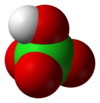Perchloric acid
|
|
|||
 |
|||
| Names | |||
|---|---|---|---|
|
Systematic IUPAC name
chloric(VII) acid
|
|||
| Other names
Hyperchloric acid
|
|||
| Identifiers | |||
|
7601-90-3 |
|||
| 3D model (Jmol) | Interactive image | ||
| ChEBI |
CHEBI:29221 |
||
| ChEMBL |
ChEMBL1161634 |
||
| ChemSpider |
22669 |
||
| ECHA InfoCard | 100.028.648 | ||
| EC Number | 231-512-4 | ||
| PubChem | 24247 | ||
| RTECS number | SC7500000 | ||
| UN number | 1873 | ||
|
|||
|
|||
| Properties | |||
| HClO4 | |||
| Molar mass | 100.46 g/mol | ||
| Appearance | colorless liquid | ||
| Odor | odorless | ||
| Density | 1.768 g/cm3 | ||
| Melting point | −17 °C (1 °F; 256 K) (azeotrope) -112 °C (anhydrous) |
||
| Boiling point | 203 °C (397 °F; 476 K) (azeotrope) | ||
| miscible | |||
| Acidity (pKa) | -15.2 (±2.0); ≈ −10 | ||
| Hazards | |||
| Safety data sheet | ICSC 1006 | ||
|
EU classification (DSD)
|
Oxidant (O) Corrosive (C) |
||
| R-phrases | R5, R8, R35 | ||
| S-phrases | (S1/2), S23, S26, S36, S45 | ||
| NFPA 704 | |||
| Related compounds | |||
|
Related compounds
|
Hydrochloric acid Hypochlorous acid Chlorous acid Chloric acid |
||
|
Except where otherwise noted, data are given for materials in their standard state (at 25 °C [77 °F], 100 kPa).
|
|||
|
|
|||
| Infobox references | |||
Perchloric acid is a mineral acid with the formula HClO4. Usually found as an aqueous solution, this colorless compound is a stronger acid than sulfuric and nitric acid. It is a powerful oxidizer when hot, but its aqueous solutions up to approximately 70% by weight at room temperature are generally safe, only showing strong acid features and no oxidizing properties. Perchloric acid is useful for preparing perchlorate salts, especially ammonium perchlorate, an important rocket fuel component. Perchloric acid is dangerously corrosive and readily forms potentially explosive mixtures.
Perchloric acid is produced industrially by two routes. The traditional method exploits the high aqueous solubility of sodium perchlorate (209 g/100 mL of water at room temperature). Treatment of such solutions with hydrochloric acid gives perchloric acid, precipitating solid sodium chloride:
The concentrated acid can be purified by distillation. The alternative route, which is more direct and avoids salts, entails anodic oxidation of aqueous chlorine at a platinum electrode.
Treatment of barium perchlorate with sulfuric acid precipitates barium sulfate, leaving perchloric acid. It can also be made by mixing nitric acid with ammonium perchlorate and boiling while adding hydrochloric acid. The reaction gives nitrous oxide and perchloric acid due to a concurrent reaction involving the ammonium ion and can be concentrated and purified significantly by boiling off the remaining nitric and hydrochloric acids.
Anhydrous perchloric acid is an unstable oily liquid at room temperature. It forms at least five hydrates, several of which have been characterized crystallographically. These solids consist of the perchlorate anion linked via hydrogen bonds to H2O and H3O+ centers Perchloric acid forms an azeotrope with water, consisting of about 72.5% perchloric acid. This form of the acid is stable indefinitely and is commercially available. Such solutions are hygroscopic. Thus, if left open to the air, concentrated perchloric acid dilutes itself by absorbing water from the air.
...
Wikipedia



